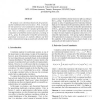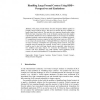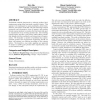419 search results - page 19 / 84 » Using Matrix Decompositions in Formal Concept Analysis |
ICDM
2005
IEEE
14 years 1 months ago
2005
IEEE
We propose a new theoretical framework for generalizing the traditional notion of covariance. First, we discuss the role of pairwise cross-cumulants by introducing a cluster expan...
ICFCA
2009
Springer
14 years 9 days ago
2009
Springer
This paper presents Binary Decision Diagrams (BDDs) applied to Formal Concept Analysis (FCA). The aim is to increase the FCA capability to handle large formal contexts. The main id...
ICASSP
2011
IEEE
12 years 11 months ago
2011
IEEE
This paper deals with the minimum polyadic decomposition of a nonnegative three-way array. The main advantage of the nonnegativity constraint is that the approximation problem bec...
AOSD
2009
ACM
13 years 5 months ago
2009
ACM
Traditional methods characterize a software product line's requirements using either functional or quality criteria. This appears to be inadequate to assess modularity, detec...
GD
1994
Springer
13 years 11 months ago
1994
Springer
Abstract. Concept lattices are used in formal concept analysis to represent data conceptually so that the original data are still recognizable. Their line diagrams should re ect th...



